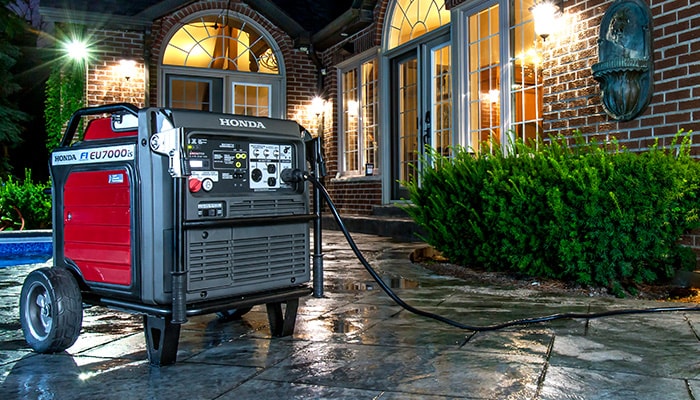Tips & Tricks
Safety Tips for Using a Stand-by Generator During a Power Outage

Power Outages are the New Normal
Living with the risk of power outages has become the “new normal” in Northern California due to rolling power outages from PG&E, wildfires, and high-demand on the electrical grid. If you plan to use a gas-powered generator to provide power during emergencies, please follow these tips to protect your family and your generator investment.
Make Sure that Your Generator Provides Safe Inverter or iAVR Power
If you are using a generator to power appliances, water well-pumps, and computers, then you need to buy a generator with safe inverter power that will provide a steady stream of power to prevent electrical surges that could damage equipment.
Honda makes two types of generators for home back-up power – their Inverter Power and Intelligent Automatic Voltage Regulator Power Series of gas-powered generators.
The Honda inverter power series (EU2200i, EU3000i, EU7000i models) of generators have inverter power technology built into the generator. Inverter power produces a smooth sine wave of continuous power that is safe to power computers and household appliances.
Honda also sells a series of generators (EM4000, EM5000, EM6500S, EM6500SX) that have their iAVR (Intelligent Automatic Voltage Regulator) technology that provide a steady stream of electricity. The iAVR series of generators are safe to power appliances and water well-pumps but not recommended to power computers with sensitive data.
Always Operate Your Generator Outside
Generators must be operated outside with plenty of ventilation.
Use High Octane Gasoline or TruFuel to Protect the Generator Engine
Ethanol-gasoline sold in California has a combination of gasoline and water to keep the air clean. Use high octane gasoline (at least 89 Octane) sold at Shell, Chevron, and Union 76 gas stations. Don’t buy cheap gas because it has more water content and will damage the engine.
How Much Gasoline Do You Need for a 1 Day Power Outage? Check the run-time on your generator and calculate how many gallons of gas are needed to operate your generator for 24 hours. For example, a Honda EU2200i generator will run up to 8 hours on one tank of gas (0.8 gallons). This means you will need 3 gallons of gasoline to run a EU2200i for a 24-hour period. We recommend that you have 5 gallons of gas on-hand if you know that your home will be without power for more than a day – but don’t forget to use that gasoline within 30-days before it goes bad. You can buy a 2.5-gallon No-Spill gas can or a 5-gallon No-Spill gas can to safely store gasoline.
Use TruFuel or Run-Out Your Gasoline Before It Goes Bad Gas goes bad after 30-days when the ethanol-gasoline and water content separate. The water content will create condensation in the fuel lines gumming-up the fuel line and jets in the carburetor and create rust in the gas tank and carburetor. This will create a very expensive repair for your generator. Either run-out the gasoline in the generator until it stops running or use TruFuel instead of gas. TruFuel is a synthetic fuel (not gas) and will help protect your generator during storage (up to 2-years). One option is to safely store your generator with TruFuel, turn-it on, and run it dry when your power goes out. If you need to run your generator for more than 8-hours then you could use gasoline – it’s cheaper than operating your generator with TruFuel.
Store Your Generator with TruFuel or Dry Without Gasoline We recommend safely storing your generator with TruFuel because it will start-up when your power goes out. The other alternative is to store your generator dry without gasoline, but that’s not really practical because you have to go buy fresh gas when the power goes out.
Stay safe and give us a call at 408-377-4496 if you questions or want to buy a Honda generator.

